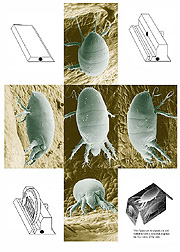This page has been archived and is being provided for reference purposes only. The page is no longer being updated, and therefore, links on the page may be invalid.
|
Read the magazine story to find out more. |
New Way to View, Identify Minute PestsBy Luis PonsMay 23, 2002 Getting a better microscopic view of a mite is now possible using a new specimen holder designed by Agricultural Research Service botanist Eric Erbe. According to Erbe, who works with the Soybean Genomics Improvement Laboratory in Beltsville, Md., the specially built holder is an important accessory for scientists interested in obtaining more complete descriptions of mites, insects and other pests. Accurate identifications of the pests are an important step toward reducing or preventing the economic losses mites cause, estimated to be billions of dollars annually. The new holder improves the accuracy of viewing mites and other species of insects and nematodes through low-temperature scanning electron microscopy (LTSEM), the method that produces those scary, detailed close-ups that look like they belong in a science fiction movie. Standard specimen holders for LTSEM viewing can cost several hundred dollars apiece, an expense that sometimes curbs experiments requiring multiple holders. Holders are also limited by the microscope stage's tilt capabilities, making it difficult for researchers to see all sides of a specimen once it is placed into the microscope. Erbe's innovative holder, made of scrap metal, allows a 90-degree tilt for observation of the edges of flat specimens. It can also be used to obtain side, front and back views of specimens normally mounted with just the top side exposed. Rotating samples in the new holder yields a series of micrographs that provides a 360-degree view of an object or specimen. Erbe has developed a unique display of insects and mites by turning these micrographs into what he calls box photos. A single photographed layout of the top and sides of a mite, insect or nematode can be copied, cut and folded to form a cube that displays the creature in three dimensions. Read more about this technology in the May issue of Agricultural Research magazine. Create a sample "box mite" from ARS' Sci4Kids web site at: /is/kids/weirdscience/story7/buildamite.htm ARS is the chief scientific research agency of the U.S. Department of Agriculture. |

